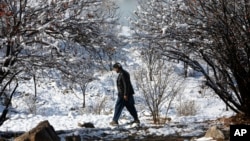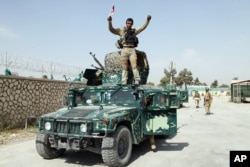Instead of a slowdown in fighting during Afghanistan's harsh winter, government security forces say they will press their operations against the Taliban and Islamic State group despite heavy snow and bitter cold.
"Taliban and other terrorist groups will not be allowed to claim territory over the next few months," Mohammad Radmanesh, a deputy spokesperson for the Afghan defense ministry, told reporters in Kabul this week.
Winter in mountainous Afghanistan, with extremely cold temperatures and deep snow, generally makes military offensives difficult and a reduced level of fighting during the winter is customary. In past years, Taliban fighters often shifted their bases to western areas of Pakistan to wait for spring thaws before returning to fight in Afghanistan.
This year, however, analysts say the Taliban is hoping to capitalize on its gains during 2016, when it opened several fronts across the country, overran government-held districts and threatened to take control of several provincial capitals.
U.S. sending 2,300 more troops
Fighting between Taliban and government forces increased during December in southwestern Helmand province, where insurgents are active in two key districts. The upsurge in fighting is believed to be the main factor behind U.S. military officials' recent announcement that 2,300 additional American soldiers are being deployed in Afghanistan, bringing the total U.S. forces there to around 9,800.
Overall, defense and interior ministry officials in Kabul say that counter-insurgency operations during 2016 by Afghan police and military forces throughout the country killed more than 18,500 enemy fighters and wounded another 12,000.
The Afghan national army last month announced the second phase of a campaign called Operation Shafaq, which began as a summer offensive. Afghan forces are concentrating on 13 of the country's 34 provinces where Taliban fighters and the so-called Khorasan branch of the Islamic State group are stronger.
Afghan provincial authorities say the focused effort by the national army has begun to pay off. They cite their recent experience in a remote eastern district of the country where hundreds of men signed up to join a government-sponsored militia after the IS fighters occupying their villages were driven off.
25 percent of Afghan territory is 'contested'
Government spokesman Radmanesh said the army has launched offensives in several insecure provinces to eliminate Taliban hideouts and regain control of areas and districts recently lost to the Taliban.
Taliban militants came close to capturing the strategic northeastern city of Kunduz in October, before Afghan forces pushed them back. The government currently controls nearly two-thirds of the country's 407 districts. The Taliban controls 33 districts, less than 10 percent of the national total, and a recent U.S. military assessment lists 116 districts — more than one-quarter of the country — as "contested" areas.
Afghanistan claims its counterterrorism offensives have been successful, although progress has been slowed by the insurgents' tactics. Taliban fighters frequently use civilians as human shields to protect themselves, and they have staged surprise attacks at times when winter weather cloaks their movements.
Fierce battles have been underway recently in eastern Nangarhar province, where Islamic State fighters have been active for the past two years.
Fighting in Nangarhar
IS militants have stormed Nangarhar's remote Pachiragam district, an area they lost during a government offensive in December. The IS assault resulted in the death of dozens of villagers and displaced hundreds of families from their homes in bitter weather.
U.S.-led NATO forces also have targeted IS locations in Nangarhar, and military experts say the winter phase of the Shafaq campaign has yielded some positive results.
The second phase of the government's campaign “has been successful, to some extent,” Kabul-based military expert Abdul Wahed Taqat told VOA. “It has also shown our troops' resilience, and the enemy has realized that Afghan forces are now capable of defending their country.”
Still, the winter offensive has been challenging for the Afghan military, making it much more difficult for senior officers to plan attacks and to transfer wounded soldiers from the battlefield.








